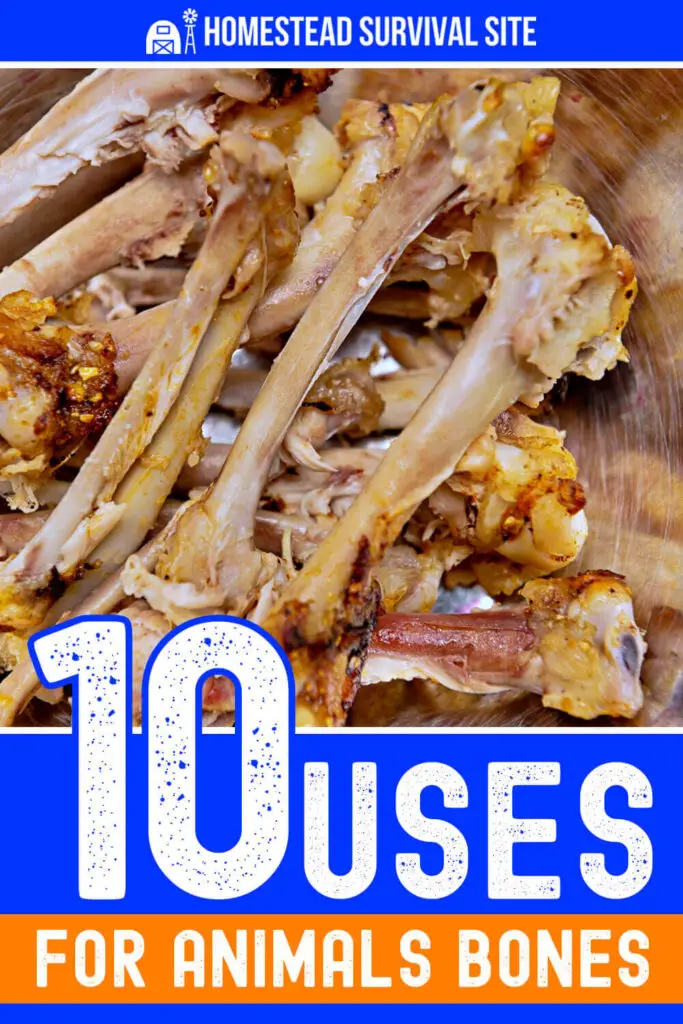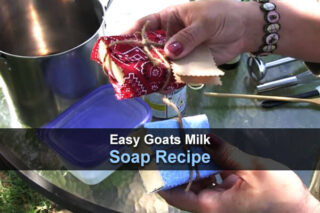Estimated reading time: 6 minutes

Since ancient times, humans have used animal bones for many purposes, including tools, medicines, and fertilizers. If you have been tossing your leftover bones in the trash after a meal, you are missing out on a valuable resource.
This article lists and describes some of the practical uses for animal bones as well as the steps to clean and prepare bones for these purposes.
1. Bone Broth
This use has gained popularity in recent years as more and more people recognize the health and nutritional benefits of drinking bone broth or using it as a soup base. Rich in minerals, vitamins, and collagen, bone broth can boost digestive health and help the body fight off infections and inflammation.
Here’s how to make beef bone broth. And this article offers a recipe for using other animal bones you might otherwise discard.
2. Bone Paste
You can also use bones to make bone paste, a nutritious survival food that has a long shelf life. It’s a healthy food your dogs will love, too. Watch this video for instructions on how to make bone paste with poultry or beef bones.
3. Bone Meal
Bone meal, a mixture of finely ground animal bones, works well as a fertilizer for your garden plants. It boosts the amount of phosphorus and calcium in the soil, helping many plants grow more vigorously. This video shows you how to make bone meal at home.
4. Tools
Native Americans often fashioned shovels and other devices from large animal bones and antlers. You can make hand tools out of smaller bones. For example. this video demonstrates how to make a bone awl. And this video shows how to make a sewing needle from a piece of bone. Bones also can be used to make small garden tools, such as spades.
5. Knives and weapons
You can also use bones to make knives, clubs, spears, and other weapons for personal protection. Here’s how to make a deer bone knife. And this one demonstrates the steps for creating a spearhead out of bone.
6. Compost
You can add clean animal bones to your compost pile to provide or replace nutrients for your soil. Be aware that bones may take a while to decompose, and, in the meantime, they may attract pests. This article delves into the pros and cons of bones as compost.
7. Adhesive
For many of us, the concept of animal bone glue conjures up horrible thoughts of horses being sent to the glue factory. However, before the invention of synthetics, people used bones to make glue for centuries.
Here’s an article describing the process, and this video shows how to make glue in 17th-century fashion using bones and rawhide. Here’s more information on bone glue.
8. Animal feed
You can use your leftover bones to make food for your pets and animals. You’ll need a grinder or food processor and some poultry, beef, or lamb bones. You can then store the meal in an airtight container in the refrigerator for up to six months. This video demonstrates how to make dog food and dog treats out of chicken bone meal.
9. Fishing hook
Certain bones work well as fishing hooks, especially in a survival situation. This video shows you how to make a fishing hook out of a deer jawbone and a multitool.
10. Health remedies
You can also use animal bones in medicinal ways. We already mentioned bone broth, which is a source of healthy fats, collagen, gelatin, amino acids, minerals, vitamins, and glycosaminoglycans (GAGs), which include glucosamine, chondroitin, and hyaluronic acid.
Eating bone marrow is another way to gain health benefits from animal bones. Marrow, the spongy tissue found in the center of animal bones, is concentrated in the spine, hip, and thigh bones. Consuming bone marrow can lower your risk of getting diabetes and cardiovascular disease.
It also can help improve bone and skin health and reduce joint pain and inflammation. Check out this article for more information on the benefits of bone marrow and how to prepare it.
How to clean and prepare leftover animal bones
The first step for all of the above uses is to clean the animal bones. A thorough cleaning helps prevent the spread of bacteria and odor. If you check online, you’ll see many methods. Some include bleaching with hydrogen peroxide, but these are often for folks who want to display their bones. Here are the basic steps to follow for the uses listed above.
- Removing soft tissue from the bone. The easiest way to accomplish this task is by soaking the bones in water for three to four weeks or longer as needed.
- Degreasing the bones. The next step is to remove the grease from the bones. A dish soap solution (Dawn dish detergent works well) and water can do the job, along with some elbow grease with a brush.
- Drying the bones. Next, spread the bones on a baking sheet or large plate and place it in a well-ventilated location. Allow the bones to dry out completely, keeping in mind that it may take a month or longer. Some people prefer to save time by using the oven or a dehydrator.
This TikTok video shows the easy process of cleaning bones for bone meal. This article (and this one) shares more of the how-tos for cleaning bones.
Conclusion
We’ll close with one more use for your leftover bones. It’s as a fuel in a survival situation. Even though bones are mostly comprised of calcium, which doesn’t burn, about 10 percent is fat content, which does burn.
Archaeologists have found that ancient people groups that lived in tundra regions without tree life used animal bones, twigs, and dry grass to make fires. The concept is that the fat inside the bone drips out as the bone heats up. The melted fat then acts as a fuel, igniting the twigs and dry grass.
Making fuel this way will not heat your home in a power shut-off, but the information may be helpful if you are in a survival situation in the wilderness.
What are your uses for leftover animal bones?
You May Also Like:









